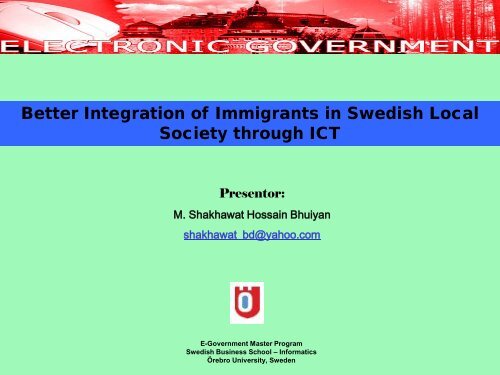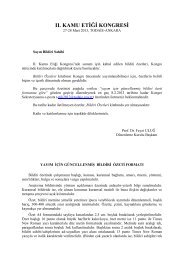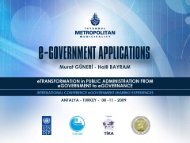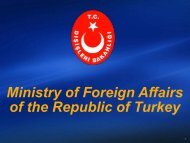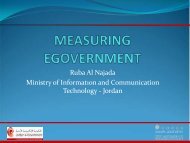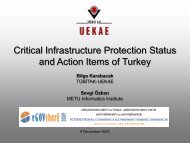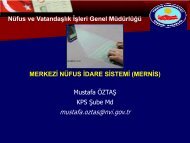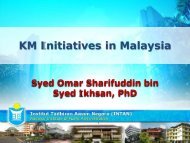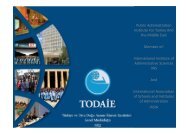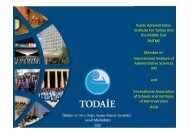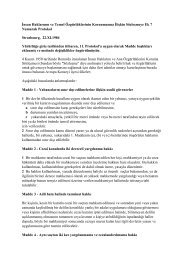Better Integration of Immigrants in Swedish Society Through ... - eDem
Better Integration of Immigrants in Swedish Society Through ... - eDem
Better Integration of Immigrants in Swedish Society Through ... - eDem
- No tags were found...
Create successful ePaper yourself
Turn your PDF publications into a flip-book with our unique Google optimized e-Paper software.
Asylum seekers 2008Iraq…………………………………. 6,083Somalia …………………………….. 3,361Serbia……………………………….. 1,989Stateless……………………………. 1,051Russia……………………………….. 933Eritrea …….………………………… 857Iran …………………………………. 799Mongolia …………………………… 791Afghanistan ………………………… 784Uzbekistan ………………………… 741Other countries…………………….. 6,964Total 24,353Source: <strong>Swedish</strong> Statistics (SCB)
Problem Identification<strong>Immigrants</strong>Multicultural PopulationDifferent Languages<strong>Integration</strong>New<strong>Society</strong>Diversified Social Values
<strong>Integration</strong> Process (Contd….)
…. <strong>Integration</strong> Process (Contd….)• Process <strong>of</strong> settlement <strong>of</strong> the immigrants <strong>in</strong> the host<strong>in</strong>g society• How it works:• "<strong>Integration</strong> <strong>in</strong>volves more than just self-support and languageknowledge, it also <strong>in</strong>volves feel<strong>in</strong>g <strong>in</strong>volved <strong>in</strong> and an aff<strong>in</strong>ity withsociety," -- <strong>Integration</strong> M<strong>in</strong>ister Nyamko Sabuni,• Occurs at <strong>in</strong>dividual and community levels• Depends on political framework, social and cultural values andthe economic conditions• Intensity <strong>of</strong> <strong>Integration</strong>:• expla<strong>in</strong>ed <strong>in</strong> terms <strong>of</strong> hav<strong>in</strong>g relative scope <strong>of</strong> hous<strong>in</strong>g,employment, education, social and cultural adoption by theimmigrants, etc.
Motivation & Research Goal• <strong>Immigrants</strong>’ Concern– Use Internet for search<strong>in</strong>g <strong>in</strong>formation– Information is limited <strong>in</strong> the Municipality websites,specially <strong>in</strong> English and/or other languages– Amount <strong>of</strong> <strong>in</strong>formation varies from language tolanguage– Lack <strong>of</strong> <strong>in</strong>formation about job market• Aim <strong>of</strong> the Research– Identify the communication gap– Maximization <strong>of</strong> the usages <strong>of</strong> ICT for <strong>Better</strong><strong>Integration</strong>
Research QuestionsQ1. What is the immigrant’s potentials <strong>in</strong> terms <strong>of</strong> ICT usage,specially Internet usage?Q2. What is the immigrant’s desire towards <strong>Swedish</strong> cultureand social values?Q3. What are the present facilities and resources as well asproblems and opportunities available for the subjectmatter?Q4. How ICT, more specifically Internet, could be used forbetter <strong>in</strong>tegration <strong>of</strong> the immigrants with the local society?
E-Government TeleologyPolitical participationthrough e-services such as onl<strong>in</strong>e vot<strong>in</strong>g and surveysVertical and horizontal <strong>in</strong>tegrationIntegrat<strong>in</strong>g separate systems at different levels (vertical) and from differentdepartments (horizontal)Services and f<strong>in</strong>ancial transactionsbetween governments and <strong>in</strong>dividuals (or bus<strong>in</strong>esses)Two way communication<strong>in</strong>teraction like request and responseInformation dissem<strong>in</strong>ationsimply post<strong>in</strong>g <strong>in</strong>formation on the web sites.Source: Hiller and Belanger (2001)
EU’s e-Government Assessment FrameworkEelaborated. This change results <strong>in</strong>m<strong>in</strong>imal overall impact at aEuropean level for year-on-yearcomparability
Method• The Survey (Q1, Q2 & Q3)– New <strong>Immigrants</strong> learn<strong>in</strong>g <strong>Swedish</strong> language <strong>in</strong> SFISchool, Wadköp<strong>in</strong>g UC, Örebro– 61 respondents captured– Operat<strong>in</strong>g variables• Ethnic orig<strong>in</strong>, education, usage <strong>of</strong> Internet/website use,personal op<strong>in</strong>ion toward availability <strong>of</strong> <strong>in</strong>formation, etc.• Interviews (Q3)– 2 adm<strong>in</strong>istrative staffs, 2 teachers & 3 students– To know the exist<strong>in</strong>g <strong>in</strong>tegration system• Q4 Q1 + Q2 + Q3
Major Characteristics <strong>of</strong> the Respondents- Nationality : Iraq (30%), Iran (10%) and Ch<strong>in</strong>a (7%)- Age range : From 21 to 70 years- Stay<strong>in</strong>g time <strong>in</strong> Sweden ranges : From 2 to 30 months- Secondary Language : English (69%), Arabic (11.4%)French (6.5%), <strong>Swedish</strong> (8.2%)- Average competency (good/ verygood/excellent) <strong>in</strong> EnglishLanguage.- Average competency (good/ verygood/excellent) <strong>in</strong> <strong>Swedish</strong>Language.: Read<strong>in</strong>g (75%), writ<strong>in</strong>g (65%) and speak<strong>in</strong>g (62%): Read<strong>in</strong>g (23%), writ<strong>in</strong>g (8% ) and speak<strong>in</strong>g (7%)- Education level completed : Secondary (1.6%), College (26.2% ),Bachelors degree (52.5% ), Masters degree (11.5%),M.Phil/Ph.D (3.3%) and Others degree (4.9%)- Have computer at home : 98%- Have Internet access foreveryday use: 95%
Percentage <strong>of</strong> <strong>Immigrants</strong> us<strong>in</strong>g Internets(Purpose & How frequently use)PurposeE-mail CorrespondenceNeverUseMonthlyOnceaWeekTwiceaWeek Daily Total5 7 3 21 64 100Search<strong>in</strong>g InformationOnl<strong>in</strong>e ServicesOnl<strong>in</strong>e Chatt<strong>in</strong>gOnl<strong>in</strong>e Distance EducationOTHERS6 11 7 18 57 10033 28 10 15 15 10028 8 7 13 44 10055 7 3 15 20 100- - 2 2 5 100
Percentage <strong>of</strong> Respondents us<strong>in</strong>g various Mediato search InformationRadioTVMedia TypeNeverUseMonthlyOnce aWeekTwice aWeek Daily Total44 16 16 8 15 10020 3 11 13 52 100NewspaperVisit<strong>in</strong>g Concerned OfficesInternet/ Website28 7 28 20 18 10048 33 10 7 3 10012 8 13 15 52 100
Relationship–Internet-based Tutorial for Learn<strong>in</strong>g<strong>Swedish</strong> Language * Time Spent Per Week Us<strong>in</strong>g InternetTime Spent Us<strong>in</strong>g Internet (Per Week)Never UsedLess than 1hourMore than1 hour butless than 4hoursMore than4 hours butless than 8hoursMore than 8hours but lessthan 12 hoursMore than12 hours TotalInternetbasedTutorial –<strong>Swedish</strong>LanguageLearn<strong>in</strong>gAgreed CompletelyAgreed a littleHad no ideaDisagreed a littleDisagreed CompletelyNon-ResponseTotal(%) (%) (%) (%) (%) (%) (%)0 3.3 11.5 8.2 9.8 23.0 55.71.6 1.6 6.6 6.6 6.6 6.6 29.50 1.6 0 0 3.3 0 4.90 0 1.6 1.6 0 1.6 4.90 1.6 0 0 1.6 0 3.30 0 0 1.6 0 0 1.61.6 8.2 19.7 18.0 21.3 31.1 100.0
Percentage <strong>of</strong> Respondents with respect to their op<strong>in</strong>ion emphasiz<strong>in</strong>g theNecessity <strong>of</strong> InformationOthers ()982Environmental Protection278341831Consumer Protection3710391031----> Information TypeSw edish Govt. OfficesInfo on Schools and Child CaresLocal Community ClubsSw edish Law and RulesCareer Guidance and JobHous<strong>in</strong>g and Transportation5223 107 7157 232 2 2 212 102333333311251811232559384415493311Non-ResponseNot ImportantLess ImportantImportantMore ImportantVery ImportantSw edish Language2 2 2161167Information about Local <strong>Society</strong>28312633Sw edish Culture2 274420260% 10% 20% 30% 40% 50% 60% 70% 80% 90% 100%----> % <strong>of</strong> Repondents <strong>in</strong> specified category <strong>of</strong> op<strong>in</strong>ion
Extent <strong>of</strong> Information gett<strong>in</strong>g from different sourcesabout <strong>Swedish</strong> <strong>Society</strong> (% <strong>of</strong> respondents)Sources/ MediaRadioTVNewspaperNoInformationNotSufficientHave noIdeaSufficientCompleteInformationTotal31 15 28 16 10 10013 15 13 38 21 10015 25 20 31 10 100Visit<strong>in</strong>g ConcernedOffices 25 8 23 31 13 100Internet/ SpecificWebsite 15 5 13 39 28 100
Percentage <strong>of</strong> Respondents visit<strong>in</strong>g major <strong>Swedish</strong> websitesto get <strong>in</strong>formation about <strong>Swedish</strong> societyMajor <strong>Swedish</strong> websitesNevervisitedVisited onlyonce ortwice Monthly Weekly Daily Totalwww.orebro.se46 23 18 10 3 100www.migrationsverket.se36 38 13 13 100www.skatteverket.se98 2 100www.hsv.se69 16 10 5 100www.sweden.se46 28 20 5 2 100www.sweden.gov.se67 20 7 7 100www.manskligarattigheter.gov.se80 8 5 7 100www.studera.nu59 13 20 7 2 100www.naturvardsverket.se78 10 7 3 2 100Others2 100
Percentage <strong>of</strong> Respondents accord<strong>in</strong>g to satisfaction level with the<strong>in</strong>formation <strong>in</strong> Örebro Municipality website (www.orebro.se)Non-response11.48%Hav e no Idea45.90%22.95%Satisfied16.39%Not Satisfied 3.28%Partially Satisfied
Highlights• Internet access (95%)• Daily <strong>in</strong>ternet use– e-mail correspondence (64%)– Search<strong>in</strong>g <strong>in</strong>formation (57%)– Onl<strong>in</strong>e chatt<strong>in</strong>g (44%)• Time spent us<strong>in</strong>g Internet per week– More than 12 hours (31%)– 8 - 12 hours (21%)– 4 - 8 hours (18%)– Never use (2%)• Introduction <strong>of</strong> Internet-based tutorial for <strong>Swedish</strong>language learn<strong>in</strong>g (85%)
<strong>Better</strong> <strong>Integration</strong>Model for <strong>Better</strong> <strong>Integration</strong> <strong>of</strong> <strong>Immigrants</strong>Exist<strong>in</strong>g tools(example)Investigation results Problems identified Recommendations(1) (2) (3) (4) (5)Participation <strong>of</strong>immigrants <strong>in</strong> localsociety throughICTCross-Govt.boundary servicesSpecific servicesfor immigrants t<strong>of</strong>acilitate<strong>in</strong>tegration (e-Services)Tow wayCommunication(Govt.-<strong>Immigrants</strong>)Info dissem<strong>in</strong>ationGovt. and local authoritywebsites and <strong>of</strong>fices, language<strong>in</strong>stitutes, Other <strong>in</strong>stitutesconcern<strong>in</strong>g health care, job,education etc.• Municipality websites,• Central government websites• Physical presence <strong>in</strong> therespective <strong>of</strong>fice or <strong>in</strong>stitutions• <strong>Swedish</strong> language learn<strong>in</strong>g atSFI, Medberganskolan• Face to face <strong>in</strong>teractions.• Partial E-mail correspondence• Telephone• Postal mailNational govt. websites,municipality websites, SFISchools, Introduktion ochMottagn<strong>in</strong>g Non-govt.organizations like Red Cross etc.Major activities are notmentioned <strong>in</strong> the policyFew l<strong>in</strong>kages with othergovernment websites• Several manual forms areused for <strong>in</strong>tegrationpurposes <strong>in</strong> SFI• Limited use <strong>of</strong> ICT <strong>in</strong>language learn<strong>in</strong>gMost <strong>of</strong> the immigrants are<strong>in</strong>ternet literate which canbe utilized and motivatedfor communicat<strong>in</strong>g withgovernment authoritiesonl<strong>in</strong>e.• Language barrier•<strong>Integration</strong> policymentionedFrustration and lack <strong>of</strong>confidence amongimmigrantsLack <strong>of</strong> l<strong>in</strong>ks forimmigrants relatedwebsites• Forms have to collectfrom the specific <strong>of</strong>fices• Language s<strong>of</strong>tware canonly be used <strong>in</strong> SFIschool• E-mail response <strong>in</strong><strong>Swedish</strong>• Cultural gap,• Lack <strong>of</strong> awareness bythe immigrants• Poor ICT usages• Limited <strong>in</strong>formation <strong>in</strong>other languages•Lack <strong>of</strong> awareness bythe immigrants• Activities should bespecified <strong>in</strong> website• Motivation <strong>of</strong> immigrantsto use ICT• Relevant web-l<strong>in</strong>k at oneplace• L<strong>in</strong>k to other Municipalitywebsites• Harmonize the contentsand services• Provision <strong>of</strong> onl<strong>in</strong>e formsubmission• Introduction <strong>of</strong> Internetbasedtutorial for <strong>Swedish</strong>language• E-mail correspondence,• Onl<strong>in</strong>e feedback• Modification <strong>of</strong> websiteswith languages, contents• Motivate immigrants forICT usage
Conclusion & Recommendations• <strong>Immigrants</strong> need motivation and awareness towardsearch<strong>in</strong>g complete <strong>in</strong>formation onl<strong>in</strong>e.• Local Authority website (like Örebro Municipality) needto l<strong>in</strong>k all aspects <strong>of</strong> <strong>in</strong>formation regard<strong>in</strong>g allgovernment activities and about society• Harmonization <strong>of</strong> the contents and services <strong>in</strong> allwebsites <strong>of</strong> cities and municipalities• Introduction <strong>of</strong> Internet-based tutorial for <strong>Swedish</strong>language learn<strong>in</strong>g• Some onl<strong>in</strong>e forms not available on immigrant issues• The activities <strong>of</strong> <strong>in</strong>tegration process accord<strong>in</strong>g to<strong>in</strong>tegration policy should be specified <strong>in</strong> a specificwebsite
Thank you all


